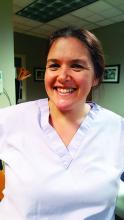Cradle to grave
Dr. Hartline’s rural training classmate Rebecca Pfaff, MD, now lives and works in Vernon County, Wisc. The clinic and the small community hospital that are her practice home are in the small town of LaFarge. A native of Washington State, Dr. Pfaff thought she’d end up there after her undergraduate years at Wellesley College and her time at Meharry Medical College, a historically black medical school with a social justice focus in Nashville, Tenn.
Speaking of her medical school years, Dr. Pfaff said, “I really tried not to go into family medicine,” thinking she’d become an obstetrician. Though she loved both the medical and surgical aspects of obstetrics, she eventually saw that family medicine gave her “that connection, where you follow the baby, and where both of them are your patients.”She realized that in the right practice setting, she could find the scope she was seeking. “I became a family medicine doctor to do obstetrics, and to do family medicine,” she said.
Dr. Pfaff chose the Baraboo rural training track, still with the intention of eventually returning to practice in her home town of Port Angeles, Wash. There, the family practice group had already hired two Baraboo graduates, so they knew the strength of the program and recommended it to Dr. Pfaff.
Seeing patients living with the challenges of rural poverty, she said, helped her learn to care for women with substance use disorder and to gain experience caring for infants with neonatal abstinence syndrome. “That is the perfect setting for where family medicine thrives,” said Dr. Pfaff. Having established relationships with the mothers, she felt able to treat the mother-infant dyad as a unit, without judgment, and with natural opportunities for frequent follow-up.
Dr. Pfaff had a busy obstetrics practice in Baraboo and had the opportunity to perform cesarean sections. To feed her interest in low-intervention obstetrics, though, she sought and was able to secure a rotation in LaFarge, her eventual practice home.
Knowing she would return to LaFarge, Dr. Pfaff went on to complete a 1-year obstetrics fellowship at Swedish Hospital in Seattle. The obstetricians and family physicians there cared for high-risk patients from as far away as Alaska; her fellowship training, she said, was in many ways “the polar opposite” of the low-intervention, community-based work she’d done in Baraboo.
Still, she said, the fellowship gave her procedural expertise and boosted her confidence that she could handle many high-risk situations. She appreciated the perspective of some of her obstetrician instructors, who themselves had been solo practitioners in rural areas.
Her practice now, she says, is everything she’d hoped it would be. She sees patients in the clinic in a cradle-to-grave practice that includes many members of Vernon County, Wisconsin’s Amish community. Dr. Pfaff and her colleagues at the small clinic in LaFarge embrace the special challenges and rewards of obstetric care of a population that has traditionally had their babies at home.
The Amish community
Using low-intervention techniques is a priority, even when many Amish women have grand multiparity or present with other risk factors. “It’s not uncommon for us to see women on their twelfth or thirteenth pregnancy,” she said. Gestation dating is usually no more than a best guess, since women become pregnant while still amenorrheic from breastfeeding their last child.
Because the area’s Amish population has grown from a small group of founders who came to the hills of Vernon County in the late 1700s, there is an elevated rate of genetic disorders in the population, including metabolic disorders and congenital heart disease. Most Amish women return home within a few hours of delivery, and use no analgesia, even for breech and twin vaginal deliveries.
Though she’s comfortable with low-intervention care, Dr. Pfaff also performs cesarean sections at the community hospital when it’s indicated, sharing call duties with the community’s general surgeons. There’s no obstetrician in Vernon County.
The hospital is not equipped to care for preterm infants, so deliveries earlier than 36 weeks’ are referred, as are patients with abnormal placentation or fetal anomalies detected on ultrasound.
She loves the continuity that her practice now lets her have, said Dr. Pfaff. “When you’re seeing a woman in family medicine, instead of seeing her at 6 weeks, setting her up with contraception, and then seeing her again in a year, you’re seeing her every 2 weeks with that baby of hers,” she said. The care of mother and infant is so intertwined that sometimes it gives Dr. Pfaff pause, as when she tries to decide in whose chart she should be documenting. “They’re a unit at this time of their lives.”
When asked if she plans to stay put, Dr. Pfaff doesn’t hesitate. “Oh yes,” she said. “I’m so lucky.”
Dr. Hartline agreed. When asked what advice she’d give a trainee considering a rural, full-spectrum career path, she said, “This is a good life. Come and join us!”
Dr. Knight is an employee of AAFP. None of the physicians interviewed had financial conflicts of interest.
Correction, 9/22/17: An earlier version of this article misstated Dr. Munneke's title.
This article was updated 9/25/17.
On Twitter @karioakes


